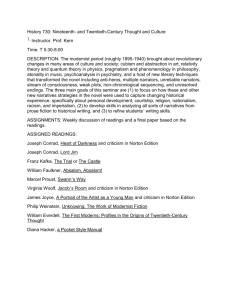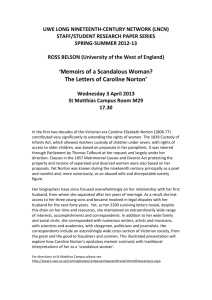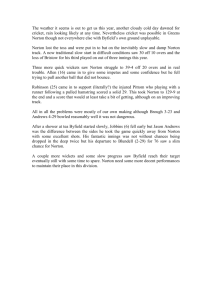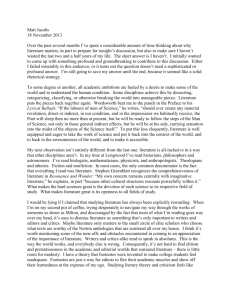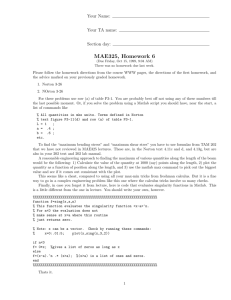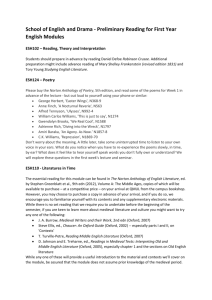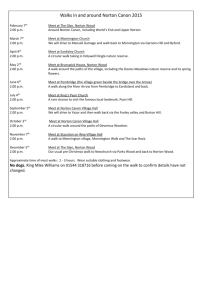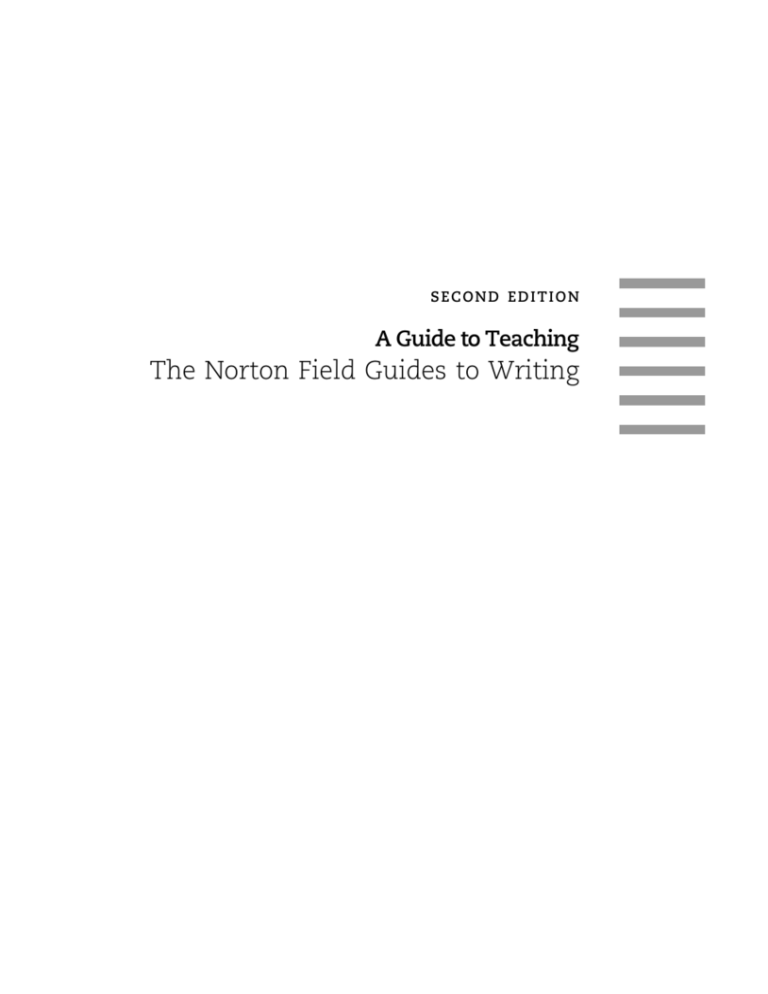
SECOND EDITION
A Guide to Teaching
The Norton Field Guides to Writing
SECOND EDITION
A Guide to Teaching
The Norton
Field Guides
to Writing
Richard Bullock
WRIGHT STATE UNIVERSITY
Maureen Daly Goggin
ARIZONA STATE UNIVERSITY
B
W. W. NORTON & COMPANY
New York • London
W. W. Norton & Company has been independent since its founding in 1923, when William Warder Norton and
Mary D. Herter Norton first published lectures delivered at the People’s Institute, the adult education division of
New York City’s Cooper Union. The firm soon expanded its program beyond the Institute, publishing books by
celebrated academics from America and abroad. By mid-century, the two major pillars of Norton’s publishing
program—trade books and college texts—were firmly established. In the 1950s, the Norton family transferred
control of the company to its employees, and today—with a staff of four hundred and a comparable number of
trade, college, and professional titles published each year—W. W. Norton & Company stands as the largest and
oldest publishing house owned wholly by its employees.
Copyright © 2010, 2009, 2007, 2006 by W. W. Norton & Company, Inc.
All rights reserved.
Printed in the United States of America
Composition: Matrix Publishing Services
Manufacturing: Sheridan Books, Inc.
Production Manager: Jane Searle
ISBN 978-0-393-93469-4 (pbk.)
W. W. Norton & Company, Inc., 500 Fifth Avenue, New York, NY 10110
www.wwnorton.com
W. W. Norton & Company Ltd., Castle House, 75/76 Wells Street, London W1T 3QT
1234567890
Contents
PART 1: Teaching Writing
1. Designing a Writing Course
2. Creating a Syllabus
3
12. Grading Student Writing
9
74
13. Teaching in a Computer Classroom
3. Designing Writing Assignments
4. Managing Class Activities
18
14. Teaching Writing Online
22
5. Conducting Class Workshops
15. Creating and Sustaining a
32
Teaching Persona
6. Working One-on-One with Students
7. Using Writing Activities in Class
9. Responding to Student Writing
36
41
8. Using Readings to Teach Writing
91
16. Balancing Graduate Studies with
Writing Instruction
46
51
10. Teaching with Writing Portfolios
11. Managing the Paper Load
79
83
65
95
17. Interacting with Students
101
18. Teaching for Inclusion and Diversity
105
19. Teaching Second-Language Writers
112
71
PART 2: Teaching with The Norton Field Guide
20. Developing Course Plans
119
21. Meeting the WPA Outcomes
22. Rhetorical Situations
27. Other Genres
131
28. Processes
23. Literacy (and Other) Narratives
24. Analyzing Texts
26. Arguing a Position
126
136
145
25. Reporting Information
29. Strategies
158
165
188
201
30. Research and Documentation
152
31. Media / Design
215
227
PART 3: Teaching the Readings
32. Literacy Narratives
TANYA BARRIENTOS,
AMY TAN,
237
MARINA NEMAT,
Se Habla Español
Mother Tongue
238
237
Bookseller
MALCOLM X,
The Secondhand
240
Literacy Behind Bars
241
v
vi
CONTENTS
ALISON BECHDEL,
The Canary-Colored Caravan
242
of Death
33. Textual Analyses
007 Is Back, and He’s
Brooding 269
Parallel Worlds: The Surprising
Similarities (and Differences) of
Country-and-Western and Rap 244
KATHARINE Q. SEELYE,
Lurid Numbers on
Glossy Pages! (Magazines Exploit
What Sells) 245
Victory Speech
34. Reports
246
The Invention of
Autobiography: Augustine’s
Confessions 275
LESLIE MARMON SILKO,
Homeless on Campus
251
JONATHAN KOZOL,
Fremont High School
252
MIKE STOBBE,
First U.S. Count Finds 1 in 200
Kids Are Vegetarian 253
ALINA TUGEND,
Multitasking Can Make You
Lose . . . Um . . . Focus 255
Our Bodies, Our Lives
256
258
AMY GOLDWASSER,
Kids Today?
STEPHEN L. CARTER,
“One of us . . . ”:
Concepts of the Private and the Public
in “A Rose for Emily” 278
38. Memoirs
280
DAVID SEDARIS,
Us and Them
Boy Army
LILLIAN SMITH,
Just Be Nice
VALERIE STEIKER,
259
261
MAGGIE CUTLER,
Whodunit—The Media?
262
GRANT PENROD,
Anti-Intellectualism: Why We
Hate the Smart Kids 263
GREGORY MANTSIOS,
Class in America—
264
266
DAVID POGUE,
No Keyboard? And You Call
This a BlackBerry? 266
Game
WILLOW D. CRYSTAL,
What’s the Matter with
258
Election Night Remarks
SETH SCHIESEL,
Language and
Literature from a Pueblo Indian
Perspective 276
ALBERTO ÁLVARO RÍOS,
BARACK OBAMA,
36. Evaluations
“Enjoy Illusions, Lad, and
Let the Rocks Be Rocks”: Le Guin’s
A Wizard of Earthsea 274
PATRICIA HAMPL,
ELEANOR J. BADER,
2003
273
PETER N. GOGGIN,
Changing the Face of
249
35. Arguments
Caught in the Ayatollah’s
271
Fantasy, Mystery, and
Ambiguity 273
251
DARA MAYERS,
Web
PHILIP NEL,
Classic Nuance: Simon Hall
at Indiana University 248
Poverty
SARAH WILDMAN,
37. Literary Analyses
GREGORY HOADLEY,
DIANA GEORGE,
The End of Life As She
268
Knew It
A. O. SCOTT,
244
DENISE NOE,
JAMES WOOD,
MICHIKO KAKUTANI,
Playing God, the Home
267
281
When I Was a Child
282
Our Mother’s Face
HENRY LOUIS GATES JR.,
39. Profiles
280
The March of the Altar
A Giant Step
284
285
287
ROB BAKER,
Jimmy Santiago Baca: Poetry as
Lifesaver 287
SAMUEL G. FREEDMAN,
Camp Leads a Drumbeat
for a Marching Band’s Style 288
NICHOLAS HOWE,
Street
JOAN DIDION,
SEAN SMITH,
Writing Home: High
289
Georgia O’Keeffe
290
Johnny Depp: Unlikely
Superstar 292
Contents
40. Proposals
293
ZORA NEALE HURSTON,
DENNIS BARON,
Don’t Make English Official—
Ban It Instead 293
PETER SINGER,
The Singer Solution to World
Poverty 294
H. STERLING BURNETT,
A Modest Proposal to
Improve Forest Management: State
Forest Block Grants 295
Colored Me
Moon
JOAN DIDION,
Grief
42. Multi-Genre Texts
RUTH BEHAR,
PETER J. BOYER,
DAVE BARRY,
GEETA KOTHARI,
300
If You Are What You Eat,
Then What Am I? 301
306
306
Of Value and Values: Warren
Buffett and the American Dream 307
Eviction: The Day They Came
for Addie Polk’s House 309
HAL NIEDZVIECKI,
Facebook in a Crowd
NICHOLAS G. CARR,
Stupid?
300
Guys vs. Men
305
The Anthropologist’s Son
MEGAN HOPKINS,
Training the Next Teachers
for America: A Proposal for
Reconceptualizing Teach for
America 298
Strawberry
303
HEIDI POLLOCK,
You Say You Want a
Resolution? 297
How It Feels to Be
302
DIANE DEERHEART RAYMOND,
JAY PARINI,
41. Reflections
vii
Is Google Making Us
311
310
Preface
First-year writing is the best course
in the university to teach.
—Toby Fulwiler
Toby is right: First-year writing courses
may be hard work, requiring of instructors
more time and energy than some other
courses, but they’re immensely rewarding.
We get to work with small classes, coming
to know our students in ways lecturers in
large halls seldom do. We get to help students learn their way around the new academic environment of college, sharing in
their excitement and anxiety. And we get
to help them explore ways of writing and
reading that are often utterly new to them,
from embedding significance in a narrative to dissecting a nonfiction text, from
immersing themselves in research to considering how best to persuade an audience. When we teach first-year English or
other writing courses, we combine complex, challenging content and strong interactions with individual writers as they go
about creating unique texts. This is a book
of resources for teachers using the second
edition of The Norton Field Guide to Writing.
No matter which of the Field Guides you
use—with the handbook, with the reader,
with both, or the rhetoric alone—this book
includes resources you’ll find useful.
Like the Field Guide itself, this book
doesn’t try to tell you everything there is
to know about teaching writing. Instead, it
tries to tell you what you’re most likely to
need to know as you teach first-year writing courses. If you want to know more, you
can find additional information at the end
of each chapter in lists of useful readings.
These lists are not intended to be comprehensive. Instead, they present one, two, or
more essays or websites that offer useful
information and helpful advice for teachers—and, usually, a good bibliography of
additional sources on that topic. You’re
busy and may not want to wade through
a lengthy bibliography; therefore, these
readings are good starting places for learning more about basic issues in teaching
writing.
This book has three parts. Part 1 consists of nineteen chapters with advice on
teaching writing, from designing a writing
course to meeting the needs of students
and adapting to a new role as a teacher.
Each chapter offers specific guidance on
developing and teaching a first-year writing course and aims to be as practical
as possible. Although knowing rhetorical
and composition theory is important—you
need to know why you teach as you do, and
theory provides that understanding—this
ix
x
PREFACE
book isn’t the place to provide theory. Our
assumption is that you need first of all to
be ready to walk into your own writing
course on the first day of class and both be
prepared and seem prepared to your students: to have a plan for your course, a syllabus to share with students, activities to
do in class, and the ability to respond to
and grade students’ writing. These chapters will help you do that.
Part 2 gives advice on teaching with
the Norton Field Guide. The Field Guide is
designed to be flexible: you can create any
number of course plans and sequences of
writing and reading assignments by combining its chapters in various ways. If
you’re new to teaching or comfortable with
a traditional guide to writing, you might
start by using Chapters 6–9: WRITING A LITERACY NARRATIVE, ANALYZING A TEXT, REPORTING
INFORMATION, and ARGUING A POSITION. These
four chapters present sequences of readings and assignments that lead students
from understanding of the key features of
the genre to the completion of a finished
essay in that genre, and you can structure
your class activities and assignments to
follow the chapter’s advice. Whichever
path you choose—or if you decide to mix
writing guides and assignments you yourself create—you should find useful advice
in Chapter 20, “Developing Course Plans
Using The Norton Field Guide.” The other
chapters offer advice, tips, and ideas for
using each of the chapters in the Field Guide.
Part 3 provides guidance for teaching
the readings in Chapters 54–64 of The Norton Field Guide to Writing, with readings and
The Norton Field Guide to Writing, with read-
ings and handbook: literacy narratives, textual analyses, reports, arguments, evaluations, literary analyses, memoirs, profiles,
proposals, reflections, and multi-genre
texts. In particular, we offer a rationale for
each of the discussion questions and writing prompts that accompany the readings,
along with guidelines for working with
each question. Additional questions for
discussion are included for each reading.
This section is guided by the assumption
that since part of learning a new genre is
learning to recognize that genre and its
conventions, reading deeply and purposefully in a specific genre helps students
develop that awareness. The readings can
also serve both as models and as inspiration for relevant topics and treatments. The
discussion questions are designed to help
students learn how to read purposefully
and to mine texts rhetorically—how, in
other words, to engage with the text. Some
questions focus students’ attention on key
features of the specific genre, others on
specific rhetorical strategies, and still others on issues and claims raised in the reading. The rationale offered for each question
indicates the intended goal and may inspire
you to design specific individual, smallgroup, or whole-class activities and out-ofclass assignments. You can find additional
advice in Chapter 8 of this book, “Using
Readings to Teach Writing.” The writing
prompts offer you an additional resource for
helping students generate topics and
approaches for writing in a particular genre.
We asked some of the best writing
teachers we know—some of them former
students, others colleagues and collabora-
Preface
tors—to contribute chapters to the book.
We think you’ll find that they succeeded
admirably, presenting good advice on teaching narrative, teaching ways to use readings,
being an effective teacher and graduate student, and dealing with special populations
of students, including those whose first language isn’t English and those with various
disabilities. We want to thank these teachers publicly for making this guide for teaching better than it would otherwise be: Brady
Allen, Adrienne Cassell, Jimmy Chesire,
Carol Cornett, Deborah Crusan, Melissa
Faulkner, Scott Geisel, and Melissa Toomey.
There are others we need to thank, too.
Jane Blakelock, assistant director of writing programs for computing in Wright
State’s English Department and also the
department’s and our college’s webmaster,
taught Rich most of what he knows about
designing electronic texts and how best to
teach them. Catherine Crowley sensitively
edited several chapters, and other instructors, lecturers, and professors in Wright
State’s English Department contributed
many ideas that found their way into the
book: Debbie Bertsch (now at Columbus
State Community College), Vicki Burke,
Byron Crews, Sally DeThomas, Stephanie
Dickey, Andrea Harris, Karen Hayes, Jeannette Horwitz, Beth Klaisner, Peggy Lindsey, Nancy Mack, Cynthia Marshall, Sarah
McGinley, Michelle Metzner, Kristie Rowe,
Bobby Rubin, Cathy Sayer, David Seitz,
xi
Tracy Smith, and Rick Strader. Thank
you all.
We owe a special debt to Paige Huskey
and Mike Boblitt, whose work in revising
and editing this manual has greatly
improved it.
Special thanks are also in order for the
people who have supported us as we’ve
worked on these field guides. Henry
Limouze, the chair of Wright State’s
Department of English, has been unfailingly supportive. Neal A. Lester, the chair
of Arizona State University’s Department
of English, has also offered unwavering
support. Marilyn Moller is the finest editor
in the textbook business and has helped us
in ways too numerous to mention. Nicole
Netherton, former assistant editor, was
helpful and cheerful in equal measure. Erin
Granville, associate editor, deserves high
praise for her editorial eye and constant
support. Ana Cooke has helped in ways
large and small with her calm efficiency
and eagle eye. Thanks also to the other fine
people at W. W. Norton who helped make
this book happen; all deserve their share
of the credit for this book. And finally we
offer gratitude to our spouses. Rich thanks
Barb Bullock, his wife and best teacher,
who each day by precept and example
teaches him to open up to life. Maureen
thanks Peter Goggin, her husband, who
nourishes her spiritually, physically, and
intellectually.
SECOND EDITION
A Guide to Teaching
The Norton Field Guides to Writing

